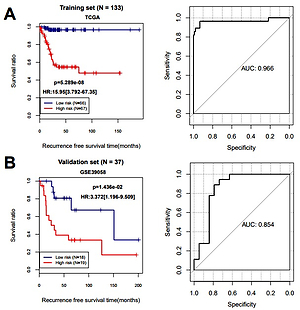Current issue
Archive
Manuscripts accepted
About the Journal
Editorial office
Editorial board
Section Editors
Abstracting and indexing
Subscription
Contact
Ethical standards and procedures
Most read articles
Instructions for authors
Article Processing Charge (APC)
Regulations of paying article processing charge (APC)
ONCOLOGY / RESEARCH PAPER
Genome-wide analysis of lncRNAs, miRNAs and mRNAs forming a prognostic scoring model associated with the recurrence of osteosarcoma
1
China-Japan Union Hospital of Jilin University, China
2
Second hospital of Jilin University, China
Submission date: 2021-02-04
Final revision date: 2021-09-07
Acceptance date: 2021-11-21
Online publication date: 2022-04-18
KEYWORDS
TOPICS
ABSTRACT
Introduction:
Purpose: Among young adults and adolescents, the most common malignant bone tumor is osteosarcoma (OS). Even patients who are cured by surgery or neoadjuvant chemotherapy still have a high possibility of recurrence. In recent years, due to the development of molecular biology research methods, many new prognostic markers based on the gene level have emerged. In addition, the mutual regulation mode among long non-coding RNA (lncRNA), miRNA and target genes are closely related to the occurrence and development of tumors. In our research, we aimed to analyze the molecular regulation mode and predict clinical outcomes by integrate three types of RNA expression.
Material and methods:
Materials and Methods: We obtained the data of OS patients from The Cancer Genome Atlas (TCGA) database including expression data (RNA and miRNA expression data) and clinical data.
Results:
Results: After differential gene expression analysis, Cox regression analysis and functional enrichment analysis, 1 lncRNA, 3 miRNAs and 9 mRNAs were identified as prognostic RNA. We constructed the prognostic scoring (PS) model with high predicting prognosis performance. Using PS models and clinical data, we established a nomogram to calculate patients' 3-year and 5-year survival rates.
Conclusions:
Conclusions: Finally, competing endogenous RNAs (ceRNAs) network and functional enrichment analysis help us to understand molecular mechanisms associated with the recurrence of osteosarcoma.
Purpose: Among young adults and adolescents, the most common malignant bone tumor is osteosarcoma (OS). Even patients who are cured by surgery or neoadjuvant chemotherapy still have a high possibility of recurrence. In recent years, due to the development of molecular biology research methods, many new prognostic markers based on the gene level have emerged. In addition, the mutual regulation mode among long non-coding RNA (lncRNA), miRNA and target genes are closely related to the occurrence and development of tumors. In our research, we aimed to analyze the molecular regulation mode and predict clinical outcomes by integrate three types of RNA expression.
Material and methods:
Materials and Methods: We obtained the data of OS patients from The Cancer Genome Atlas (TCGA) database including expression data (RNA and miRNA expression data) and clinical data.
Results:
Results: After differential gene expression analysis, Cox regression analysis and functional enrichment analysis, 1 lncRNA, 3 miRNAs and 9 mRNAs were identified as prognostic RNA. We constructed the prognostic scoring (PS) model with high predicting prognosis performance. Using PS models and clinical data, we established a nomogram to calculate patients' 3-year and 5-year survival rates.
Conclusions:
Conclusions: Finally, competing endogenous RNAs (ceRNAs) network and functional enrichment analysis help us to understand molecular mechanisms associated with the recurrence of osteosarcoma.
Share
RELATED ARTICLE
We process personal data collected when visiting the website. The function of obtaining information about users and their behavior is carried out by voluntarily entered information in forms and saving cookies in end devices. Data, including cookies, are used to provide services, improve the user experience and to analyze the traffic in accordance with the Privacy policy. Data are also collected and processed by Google Analytics tool (more).
You can change cookies settings in your browser. Restricted use of cookies in the browser configuration may affect some functionalities of the website.
You can change cookies settings in your browser. Restricted use of cookies in the browser configuration may affect some functionalities of the website.



